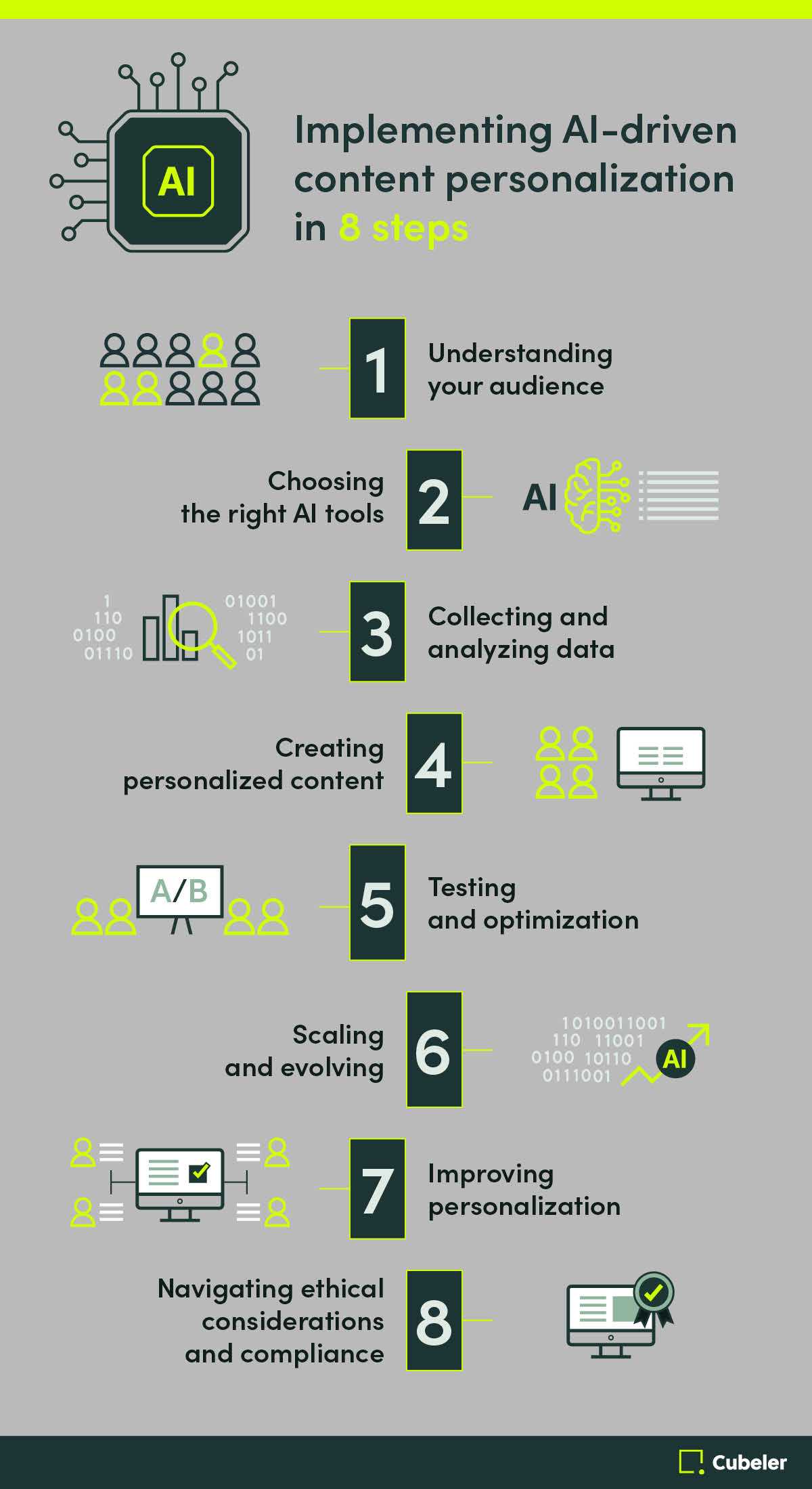3 min read
Rule Your Niche in 2024 with 8 AI Power Moves
By:
Cubeler en-ca
January 26, 2024 5:32:55 EST PM

Offer your customers exactly what they want, even before they know they want it, with AI-driven content personalization.
Table of contents
Ready to take your business to the next AI level? Think AI-driven content personalization. It's not just a buzzword—it's a game-changer that can catapult your customer engagement and business growth into new territory.
Imagine offering your customers exactly what they want, even before they know they want it. With AI personalization, you're not just selling a product or service—you're crafting unique experiences tailored to each customer.
It's time to stand out with AI-driven content personalization and watch your SME grow like never before.
To get started, here's a guide for implementing AI-driven content personalization—with actionable steps and real-world examples:
1. Understanding Your Audience
Analyze your audience's demographics, interests and online behaviour. Tools like Google Analytics can provide insights into user preferences and behaviour.
Additionally, engage in social listening and conduct surveys to gain deeper insights into customer needs and expectations.
Example: Boutique online retailers use data analytics to understand the shopping preferences of their customers, allowing them to personalize product recommendations.
| Join Cubeler to get access to the full digital marketing report |
| Sign up now > |
2. Choosing the Right AI Tools
Select AI tools and platforms that best fit your business model and customer data. Options include AI-powered content management systems, recommendation engines and customer relationship management (CRM) tools.
Evaluate the scalability, user-friendliness and integration capabilities of these tools with your existing systems.
Example: Small and medium-sized travel agencies implement an AI-powered CRM to personalize travel recommendations based on past bookings and searches.
3. Collecting and Analyzing Data
Gather data from various touchpoints like websites, social media and customer interactions in accordance with applicable data protection laws.
Implement systems for continuous data collection and analysis to keep your personalization strategies relevant and up-to-date.
Example: Small and medium-sized e-commerce stores integrate their website and social media analytics to create a comprehensive view of customer interests.
4. Creating Personalized Content
Use AI to create or curate content tailored to individual preferences. This could be product recommendations, personalized emails or dynamic website content.
Ensure that the content is not only personalized but also adds value to the customer, enhancing their experience and engagement.
Example: Small and medium-sized health and wellness companies use AI to send personalized health tips and product recommendations to their customers based on their browsing history.
5. Testing and Optimization
Continuously test different personalization strategies and measure their impact on customer engagement and sales. Use A/B testing to refine your approach.
Analyze the results to understand what works best for your audience and be prepared to adapt your strategy accordingly.
Example: Small and medium-sized online bookstores test different layouts and recommendation algorithms to see which ones yield higher engagement and sales.
6. Scaling and Evolving
As your business grows, scale your AI personalization efforts. Stay updated with AI advancements to continuously improve customer experience.
Regularly revisit your strategy to ensure it aligns with changing customer preferences and technological advancements.
Example: Small and medium-sized online fashion retailers employ more advanced AI algorithms to handle increased traffic and diversify personalized content.
7. Feedback and Improvement
Regularly seek customer feedback to understand the effectiveness of your personalization. Use this feedback to make improvements.
Create a feedback loop where customer responses directly inform and enhance your personalization strategies.
Example: Small and medium-sized specialty food outlets conduct customer surveys to gauge the success of their personalized recipe recommendations.
8. Ethical Considerations and Compliance
Ensure that your personalization strategies are ethically sound and compliant with regulations like GDPR.
Regularly review and update your practices to maintain ethical standards and compliance with evolving data protection laws.
Example: Tech startups revise their data collection methods to be more transparent and compliant with new data privacy laws.
By following these actionable steps, your small or medium-sized business can effectively implement AI-driven content personalization, enhancing customer experiences and driving business growth.
Remember: As AI technology continues to evolve, it will offer you a competitive edge for as long as your business can leverage it effectively.
| Join Cubeler to get access to the full digital marketing report |
| Sign up now > |


/cubeler-insights-blog-1381x907.jpg)